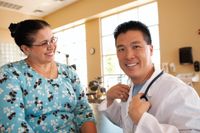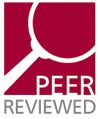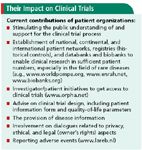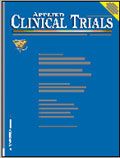Patient Power
Advancing medicine and the clinical research process with the help of patient organizations
1.) Preapproval Opportunities
2.) Mission Possible: Rebranding Clinical Research
3.) Recruitment Strategies: A European Perspective
The essential role that patient organizations can play in the research process, particularly in clinical trials, is often overlooked. The last four decades show not only a steady growth of the number of patient organizations but also an increasing interest in the research process and drug development.

Getty Images
Nowadays, patient organizations can offer traditional, scientific research additional knowledge. Knowledge that is derived from the practices and experiences from the patient organizations.
The combination of traditional, scientific knowledge (evidence based) with the practice based-knowledge from patient organizations creates an added value. This added value can play an important role in the development of clinical trials.
Several examples of this added value will be mentioned in this article. Furthermore, the article explores the differences between patients, consumers, and clinical trial participants.
Unique roles
There is a large difference between consumers as incidental users of health care and patients who are more or less constant users of health care services. The citizens of our society in their role of consumers are mostly interested in minimizing their health care insurance costs. These same citizens in their role as patient are more interested in questions such as where do I find the best doctor? The best hospital? And the best treatment or medication for my disease?
As a consequence, patient groups stand more alongside the research community, acting as a critical friend and as part of the process to find solutions for unmet medical needs. On the contrary, consumer organizations take a more confrontational stance, stressing the risks, dangers, and problems of medical research.
The difference between consumers and patients is also relevant when answering the question: Who is the trial participant?
The trial participant can be a healthy volunteer who is getting paid for their cooperation. The trial participant can also be a consumer, who all of a sudden gets ill and at the time of the diagnosis will be asked to participate in a trial with relatively little background knowledge. And in regard to providing informed consent, has had little or no time to think about the decision. The trial participant can also be a patient, partially organized in a patient group or aware that there is a patient group and has some background knowledge of the condition and respective treatment options.
Trial participants are seldom organized, nor have contacts with patient or consumer groups. Trial participants are represented in research ethics committees (EC) by laypersons, and these laypersons also have almost no contacts with trial participants and patient or consumer groups.
For most clinical research organizations, investigators, and pharma companies, it's not easy to contact potential trial participants if they're not organized in patient groups.
A changing role
Where in the past, patient organizations focused on their three traditional roles—education/information, peer support, and advocacy—they now play a fourth role: consultant and participant in scientific research and related policy issues.

When Circumstance Breeds Change
The story of Patrick and Sharon Terry [see sidebar] is an example. Another example is EULAR (European League Against Rheumatism) and OMERACT (Outcome Measurement in Rheumatology Clinical Trials). A traditional endpoint in clinical research for rheumatoid arthritis was pain. Input from patient groups resulted in the formulation of two new endpoints: fatigue and sleeplessness.1
This development illustrates how patient organizations can provide clinical research with additional knowledge, which translates into additional value.
Needed changes
The involvement of patient organizations comes at a time when a new paradigm for the clinical trial process is needed. Sir Michael Rawlins of NICE described it as inefficient, outdated, slow, and expensive.2
There are several reasons to go for a new paradigm: the increasing costs and time needed to conduct a clinical trial; a lack of patients for clinical trials in several disease areas; and a lack of knowledge and awareness in society about the need for clinical trials.
To the statement of Rawlins can be added the outcome of the recent European Commission–EMEA conference, "The Operation of the EU Clinical Trials Directive (Directive 2001/20/EC) and Perspectives for the Future," which officially confirmed earlier anecdotal doubts about the fact that the EU rules don't work properly.3 More recently on December 1, 2008, in Brussels the results of the ICREL (Impact on Clinical Research of European Legislation) survey were discussed. These results also confirmed the outcome of the 2007 European Commission-EMEA conference. ICREL's aim is to measure and analyze the direct and indirect impact of the Clinical Trials Directive 2001/20/EC and related legislations in the EU on all categories of clinical research and on the different stakeholders: commercial and noncommercial sponsors, ethics committees, and competent authorities.4
Several patient groups also expressed their concerns about the EU Clinical Trials Directive and asked for more involvement of patient organizations in the clinical trial process, especially participation of patient groups in research ECs. Early, active involvement of patient organizations in clinical trials will not only contribute to therapies that are better adapted to the needs of patients but will also contribute to the cost effectiveness of clinical trials and health care in general.

Getty Images
Thus, the need for involving patients not only as subjects but also as partners in investigator and industry trials originates from patient organizations and from other stakeholders in clinical research. In addition, there are societal changes stimulating new inter-stakeholder relationships in this area, with patient emancipation making patient–doctor relations increasingly equal instead of paternalistic.
Patient organizations represent the patient's needs, views, and perspective. In addition to their better known role in the informational and psychosocial support area, patient organizations increasingly realize the value of their expertise for biomedical research. As a result, patient organizations are increasingly willing to contribute to the drug and therapy development process, especially in serious disease areas without either adequate care or stabilization of symptoms. Patient involvement is not only limited to biomedical research but also exists in the development process of medical treatment guidelines and standards of care.
Patient input
The closer involvement of patient organization representatives can also be expected to add value to the clinical trial process. This added value could, for example, manifest itself in clearer formulation of written patient information material such as the informed consent form; the debate over whether or not a particular type of research is stressful for a given patient group; the question of whether or not the required number of trial subjects is achievable; and the debate over whether or not a particular type of research ought to be suspended in the event problems arise.
Patient organizations can also be asked by the research ECs for their opinion in cases where research that directly concerns them is on the agenda. In those cases where this type of dialogue does not take place, patient organizations will be less willing to accept the decisions of the ECs.
As a result, this can delay the process when researchers or ECs overlook practical problems for patients to participate. There is also the possibility that when suggestions from patient groups are accepted, the new research proposal will have to be seen again by the EC, causing delays.
European outreach
It is unrealistic to expect that the process of involving patient organizations in the clinical trial process can happen overnight, but it does seem sensible to reflect on this involvement and to embark on a dialogue. Patient organizations will have work to do on this process also. They must learn to look beyond the problems that are specific to their own particular disease, which will require a certain amount of skills and background knowledge.
To work on this, the European Network of Patients Partnering for Clinical Research was recently established to identify the needs for patients partnering in clinical research. They formulated a PatientPartner project that has just received a substantial FP7-grant from the European Commission to work on these issues.
This project is being done by key European and national patient network organizations under the umbrella of European Genetic Alliances Network (EGAN) and the European Forum for Good Clinical Practice (EFGCP).
The future
The PatientPartner project is an indication that European patient groups are on their way to play their part in the clinical trial process. Certainly this will lead to the identification of problems that have to be solved by them or by acting together with policymakers and regulators.7 Among the future problems and action steps that can now be identified are:
The trial process. The potency of patient organizations in the different phases of clinical research is not clear and not used. An example is the adjudication of risk and benefit. Certainly with incurable diseases, there is little likelihood of a direct benefit to the participant. However, the hope of a benefit is perhaps a significant driver for those affected.
How can research using patients put this into the right context? How acceptable is it to offset societal benefits against individual risks, and is there a case for allowing greater level of risks to be tolerated if the benefits to society are potentially large? Does understanding of risks change patient behavior and if so, how? Is the notion of altruism really a factor in individual decision making? And do the answers to these questions change if children are involved?
Governance, policy, and positioning. There is a big gap between the increasing willingness of patient organizations to participate in the different aspects of clinical trials and the legal room that exists to really fulfill that role. The added value of the involvement of patient organizations in the governance of clinical trials is either not clear or not used at the respective levels of the EU (guidelines, directives, regulations), their different member states (national legislation) and the trial level (organization, coordination).
For patient organizations, it is important to understand the interests and the driving forces of the other stakeholders, the constraints exercised on public and private sector researchers and clinicians, and the regulatory and policy frameworks in which they have to operate. Mutual understanding between these stakeholders will improve the quality of the research, but structural dialogue between patient groups and the other stakeholders is still in its infancy.

Their Impact on Clinical Trials
Areas of current and future interest. Patient groups are urgently needed in specific areas of ethical and organizational complexity. It is not yet clear how patient groups can fulfill this role, for instance, in the case of pediatric research and in the availability of patient registries, clinical data banking, and biobanking. Pediatric research is particularly sensitive because of the potential for exploitation of vulnerable minors unable to give informed consent. Yet without this research childhood diseases will remain poorly treatable.
Generating the critical mass of data or samples that will allow effective and efficient research to proceed involves biobanks and registries. Patients have valuable experiences in living with their illness. In combination with their biological and genetic data, they can be regarded as living databases. Patient data is not used efficiently or in combination with modern information technology.
Only in close cooperation with patients can these resources be efficiently applied in clinical research. Thus, patient organizations aim at more involvement in issues that may affect their health and lives, and in more patient-centered clinical research, shared responsibilities, and increased access to clinical research and its outcomes.
To reach this level of involvement, the PatientPartner project has been set up, and it is hoped that the project will deliver answers in about three years.
Then and now
Since the early 1970s, numerous disease-specific patient organizations have been founded, first at a national level and also internationally as umbrella groups. In the last decade, Europe also saw an increase of disease-specific umbrella groups as a result of the growing attention of the European Commission for health care issues.
At the moment, most countries count more than 500 disease-specific patient organizations or self-help groups. The most recent overview of European patient groups can be found in the European Patient Group Directory 2008, which describes around 140 patient and consumer organizations.8 This Directory is categorized into diseases (cancer, mental health), age categories (children, elderly), and more general categories like public health and consumer interests.
In 2003, the European Patients Forum (EPF) was founded as a disease exceeding umbrella group. Most European disease-specific patient groups are represented in the EPF, which at the moment is the most important spokesperson for the European Commission. With regard to clinical trial issues, important European patient groups are Eurordis (European Organization for Rare Disorders), EGAN, EATG (European AIDS Treatment Group) and ECPC (European Cancer Patient Coalition).
Most European groups have an international partner. So, comparable with Eurordis there is the North American Organization for Rare Disorders (NORD), and for EGAN there is the International Genetic Alliance (IGA). The European Patients Forum has its international counterpart in the International Association of Patients' Organizations (IAPO).
Acknowledgement
The author gratefully acknowledges the support of Alastair Kent (GIG-UK), Cor Oosterwijk (VSOP-NL), IJsbrand Poortman (IGA), and Maarten de Wit (Omeract) for their comments on earlier concepts of this article.
Cees Smit, h.c., has worked for several patient groups and is an advisor to the European Genetic Alliances' Network (EGAN), email: smit.visch@wolmail.nl
References
1. J.R. Kirwan et al., "Patient Perspective: Fatigue as a Recommended Patient Centred Outcome Measure in RA," Journal of Rheumatology, 34 (4) 1174-1178 (2007).
2. M. Rawlins, "Cutting the Cost of Drug Development," Nature Reviews Drug Discovery, 3 (1) 360-364 (2004).
3. European Medicines Agency, The operation of the EU Clinical Trials Directive (Directive 2001/20/EC) and Perspectives for the Future (EMEA, London, 30 November 2007).
4. FP7-ICREL, www.efgcp.be.
5. S. Rozendaal, It's My Life, A New Revolution Patient Power (Aspekt, Soesterberg, The Netherlands, 2007).
6. "Nature Genetics," Editorial, The Advocates, 391 (April 2006).
7. PatientPartner, Identifying the Needs for Patients Partnering in Clinical Research, Project Proposal for the EU P7, EGAN/EFGCP (January 2008).
8. PatientView, European Patient Group Directory 2008 (Burson-Marsteller, Brussels, 2008).

Improving Relationships and Diversifying the Site Selection Process
April 17th 2025In this episode of the Applied Clinical Trials Podcast, Liz Beatty, co-founder and chief strategy officer, Inato, discusses a number of topics around site engagement including community-based sites, the role of technology in improving site/sponsor relationships, how increased operational costs are impacting the industry, and more.
SCOPE Summit 2025: Enhancing the Patient Experience Through Site Centricity
February 12th 2025In an interview with ACT senior editor Andy Studna at SCOPE Summit, Ashley Davidson, vice president, product lead - sponsor tech strategy, Advarra, highlights the need for more site-centric approaches in study startup.